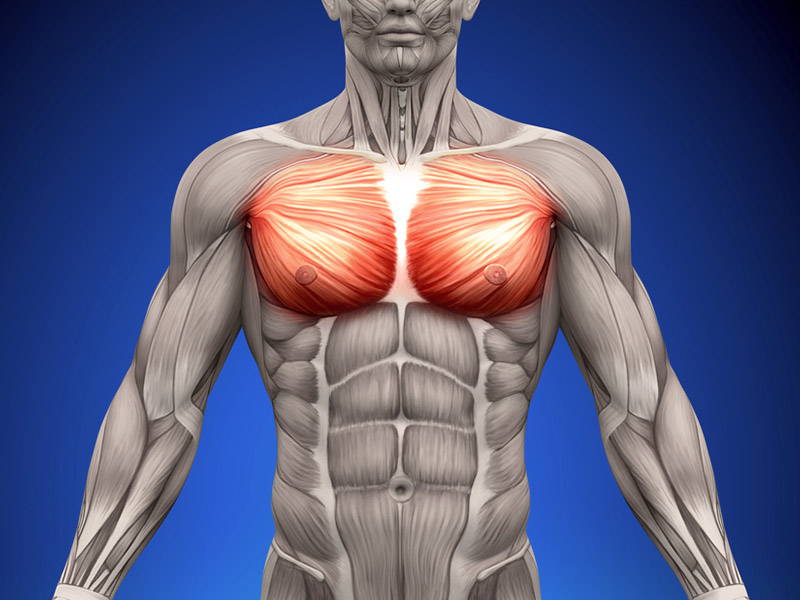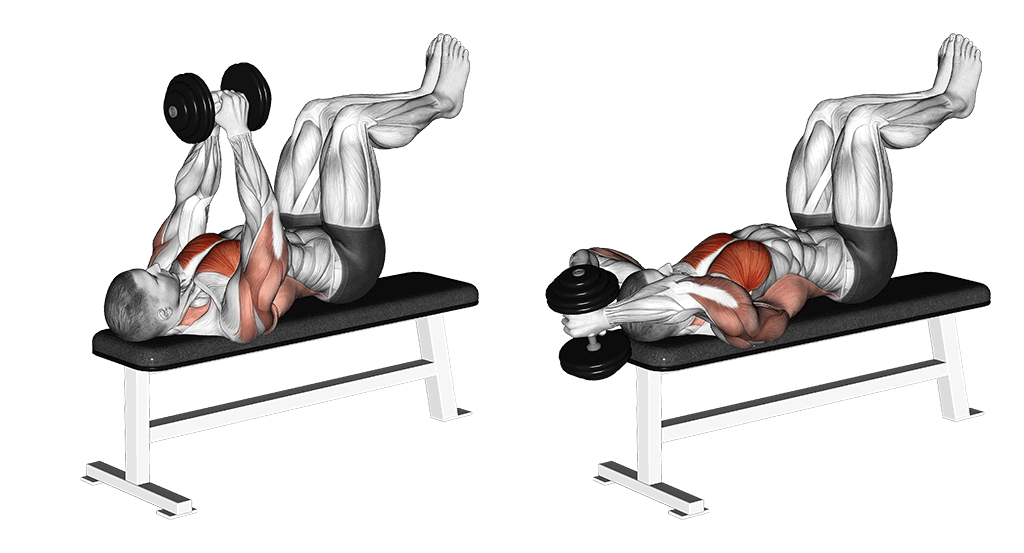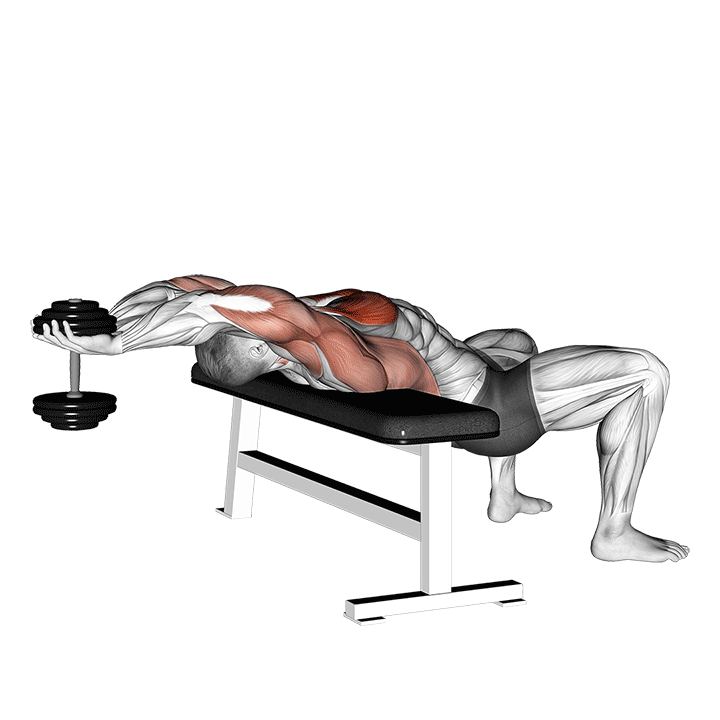
How to do a Dumbbell Pullover: Tips, Mods, & Variations
Key Takeaways
- The dumbbell pullover works the pectoralis major and the lats, with the triceps and deltoids assisting. This exercise can be modified or varied for greater muscle activation.
- Dumbbell pullovers first became popular as a breathing exercise, helping to expand the rib cage. It grew into a bodybuilding favorite for some, including legends like Bill Pearl and Frank Zane.
- Continue reading to learn the proper form for the dumbbell pullover, including tips from Frank on how to do it right.
The dumbbell pullover is an old exercise that was popular for decades, but isn’t seen as much now. That doesn’t mean this exercise isn’t effective, though.
If you’re looking for more ways to use dumbbells in your workout, dumbbell pullovers might be for you. This exercise can be modified and varied to work different muscle groups at various angles.
Some of bodybuilding’s biggest names have used the dumbbell pullover to improve their physique. Learn all about:
- The muscles worked
- Proper form
- How bodybuilders do it
- Tips for success
- Modifications and variations
Dumbbell Pullover: Muscles Worked
One of the biggest debates with the dumbbell pullover is what muscles it works, the chest or back?
The latissimus dorsi and pectoralis major are the two primary muscle groups worked with the dumbbell pullover. A study in the Journal of Applied Biomechanics tested which muscle group benefited more from the barbell pullover.

In the study, researchers used an EMG machine to see which muscle worked harder. It turns out; they activated the pecs more than the lats. So while both benefit, the dumbbell pullover is better for developing the chest.
The posterior deltoid, pectoralis minor, rhomboids and long head of the triceps also work as synergists for this exercise. Stabilizers include the triceps brachii, clavicular head of the pectoralis major and anterior deltoid.
The dumbbell pullover can be modified or adjusted to hit the muscles at different angles. Certain variations will also activate the core muscle, as will using heavier dumbbells.
Benefits of the Dumbbell Pullover
Other than building the chest and lat muscles, what other benefits can be found with dumbbell pullovers?
There are a few:
- Core stability: A strong core has many benefits, including better posterior. When included with other exercises in a HIIT-style training, dumbbell pullovers have proven effective at strengthening the core muscles.
- Improved heart and lung function: We discuss this benefit more in the next section, but the dumbbell pullover has shown to improve chest expansion. This builds respiratory strength, with the lats and pecs aiding as respiratory accessory muscles.
- Better Upper Body Balance: Weight lifting can lead to imbalances throughout the body. It’s not uncommon for men to train the front of their torso more than the back. It’s easier to check form and see the changes going on, to adjust as needed for uniformity. Dumbbell pullovers work both the front and back of the upper body to help balance it out. Making small tweaks to the movement can also bring more focus to the lats if desired.
Before we go over the steps for proper form, let’s look back in time at the history of the dumbbell pullover.
The History of the Dumbbell Pullover
The dumbbell pullover has been around since the early 1900s. What’s interesting about it is originally, it was used more as a breathing exercise than one to build muscle.

The dumbbell pullover gained in popularity after 1911, thanks to Alan Calvert’s Super Strength book. In it, he discussed two benefits of the exercise: improved breathing capacity and muscle around the ribcage.
In the 1920s, weight gaining programs were all the rage. Dumbbell pullovers were used to finish out 20 reps of squats to help with building out the rib cage in a full-body workout.
Once the 60s and 70s came about, the bodybuilding scene was in full swing. Dumbbell pullovers became a secret weapon for guys like Mike Mentzer, Bill Pearl, and Frank Zane.

According to Zane, the three were able to pull off the coveted vacuum pose because of pullovers. Zane and Pearl preferred dumbbell pullovers while Mentzer preferred Nautilus pullovers.
Arnold Schwarzenegger was also a fan of dumbbell pullovers. He credits them with expanding his rib cage, just like others before him.
Even today, the dumbbell pullover is considered a postural exercise and is still used to improve cardiopulmonary function.
Now that you know the benefits of the dumbbell pullover, let’s go over the proper form. We’ll then get some tips from Zane before offering some alternatives and modifications.
Dumbbell Pullover: Proper Form
Before you try dumbbell pullovers, make sure you have full shoulder mobility with no impingement. To perform this exercise correctly, you’ll need full range of motion in the deltoids.
If you’ve had a previous shoulder injury, this might not be the right exercise for you. Even if you’re not in any pain now, dumbbell pullovers could cause a flare up.
The equipment needed for dumbbell pullovers is minimal, just a flat bench and a single dumbbell. Choose a light weight dumbbell to practice your form before you add heavier weight.
Don’t forget to do some warm-up exercises before you get started. Forearm wall slides and arm swings are two exercises you can incorporate into your warm-up to get the shoulders prepared.

Dumbbell Pullover Instructions
- Sit on the seat of a flat bench with a dumbbell in your hand. Lay down flat on the bench so that your head is at the top of the bench and your neck and back are supported.
- Hold the dumbbell in both hands by the handle or by gripping the inner plate of the dumbbell.
- Position the dumbbell so your elbows are slightly bent and the dumbbell is at chest level.
- Engage your core and lift your hips slightly if needed for stability.
- Begin to move the dumbbell past your face and over your head. Continue along this path until your biceps are along your torso or you can’t move them down any further.
- Bring the dumbbell back over your head and past your face until you’ve reached the starting position.
Complete 8 to 10 reps for two sets with up to 90 seconds of rest in between as needed. Work your way up to three sets with the same dumbbell before increasing the weight.
Now if you’re a serious bodybuilder putting up heavy weights, there is a better way to do the dumbbell pullover.
The Bodybuilder Dumbbell Pullover

According to Frank Zane, you can bring in activation of the serratus muscle by using this form:
- Rather than lay along the flat bench, you’ll use it as a headrest. Place your torso perpendicular to the bench with your head hanging over the side. The base of your skull should be on the edge of the bench with your shoulders supported.
- Elevate the hips slightly as needed for stability without engaging the core.
- Hold the dumbbell over your face with elbows bent and begin to lower it back behind your head in an even tempo. Continue to pull the dumbbell down behind your head as far as you can, trying to touch the floor with your hands.
- Keeping the elbows bent, bring the dumbbell back up slowly to lengthen the concentric phase.
- Continue to bring the dumbbell back over your head, stopping once it’s above your nose or mouth.
This is one rep of the dumbbell pullover. Complete 8 to 10 reps for three sets, taking up to two minutes of rest between sets as needed.

You can check out this video of Zane coaching IFBB Classic Physique Pro Sadik Hadzovic through the exercise.
Tips for Success with Dumbbell Pullovers
Just like any other exercise, performing dumbbell pullovers correctly is key to muscle activation. Avoiding injury, especially to the shoulder joint, is another reason correct form is important.
Here are a few tips to use for continue success when including the dumbbell pullover in your routine:
- Bringing the elbows closer to the body by internally rotating the shoulder joint can deepen lat activation.
- Deepen the stretch as you bring the dumbbell over and beyond your head by slowing the tempo. You won’t get near enough muscle activation and cardiopulmonary benefit if you allow momentum to take over. Focus on each phase of the exercise and allow each rep to last a few seconds for maximum results.
- The upper back and hips should be supported when doing your dumbbell pullover reps. Both versions will use the bench as support for the upper back. The bodybuilder version requires you to use your legs to support your hips rather than the bench. Proper support will avoid neck and lower back soreness or injury.
- Keep the palms facing each other throughout the exercise. If you notice the palms rotating up, the weight is too heavy. Grab a lighter weight and continue working through the sets, making sure your wrists stay strong throughout.
Modifications and Variations
The dumbbell pullover can be modified if needed. There are also variations that can be done to activate the muscles differently.
Let’s start with modifications first.
Modifications
If you find the dumbbell pullover too difficult as outlined here, you can modify it to make it easier. This modification will limit the range of motion, so muscle activation will not be as great.

The dumbbell pullover can be done without a bench if one isn’t available. Rather than use a flat bench, lie flat on the floor and complete the dumbbell pullover.
Move the dumbbell over your head until it touches the floor, pause for a second, then lower. Be sure to pause with the dumbbell above the floor so you’re holding the entire weight in the air.
Variations
Variations provide a greater challenge to the user.
One way to up the ante is to use a:
- Barbell
- EZ bar
- Cable machine
Using a different piece of equipment can mean heavier lifts and different grip angles. Use and overhand grip when using the barbell. This could limit your range of motion, so be sure to have a spotter handy if you’re lifting heavy.

Standing and using the cable machine with the cable set high will improve lat activation. You can also do a lying decline pullover, which has you lying on a decline bench pulling the low cable.
Another variation includes using a stability or medicine ball rather than the bench. Rather than using the bench to support the neck and head, the ball will act as support. Be sure to engage the core, glutes and hips for stability, as it’s more important here than on a stationary bench.
Tip From The Coach

“The dumbbell pullover is a great exercise for increasing the size and depth of the ribcage. This is an aspect of the physique that is often forgotten about when it comes to improving the look of the physique. Thanks to the new Classic Physique division, the vacuum pose has become more important and the method of doing a vacuum pose has taken on greater importance.
— John Hansen, 3-time Natural Olympia winner and OSL ambassador
Many bodybuilders were able to increase the size of their ribcage by incorporating dumbbell pullovers into their workouts at a young age. I began training at 14 years old and I did dumbbell pullovers every chest workout when I was younger and, as a result, I developed a big ribcage.
Having a bigger ribcage made it much easier to do a vacuum pose and it also made poses like the front double biceps, the front lat spread, and the side chest pose much better.”
Here are two bodybuilding routines for the chest and back that include dumbbell pullovers:
Chest
- Barbell Bench Press – 4 sets – 6-12 reps
- Incline Dumbbell Press – 3 sets – 6-10 reps
- Flat Bench Dumbbell Flyes – 3 sets – 8-10 reps
- Dumbbell Pullovers – 3 sets – 10-12 reps
Back
- Dumbbell Pullovers – 3 sets – 10-15 reps
- Wide Grip Chins – 3 sets – 6-10 reps
- Barbell Rows – 4 sets – 6-10 reps
- Seated Cable Rows – 3 sets – 6-10 reps
- Deadlifts – 3 sets – 6-8 reps
Wrapping Up
The dumbbell pullover is an exercise to master for better chest and back (lats) muscle activation. Consistently using dumbbell pullovers can also improve cardiopulmonary function. Bodybuilders can also work towards nailing the vacuum pose with this exercise.
People with prior shoulder injuries should only do this exercise if they receive the okay from their doctor. The dumbbell pullover is a versatile exercise which can be done with a barbell, dumbbell or cable machine.
If you’re looking for a way to balance your upper body from front to back, consider dumbbell pullovers. They can be included in your chest or back day to enhance muscle activation and thickness. Using Vintage Build™ after a workout will strengthen the muscle and aid in recovery so you’re ready to go after a rest day.
Do you incorporate dumbbell pullovers into your workout routine? Which variation do you prefer? We’d love to hear your thoughts in the comments below.









